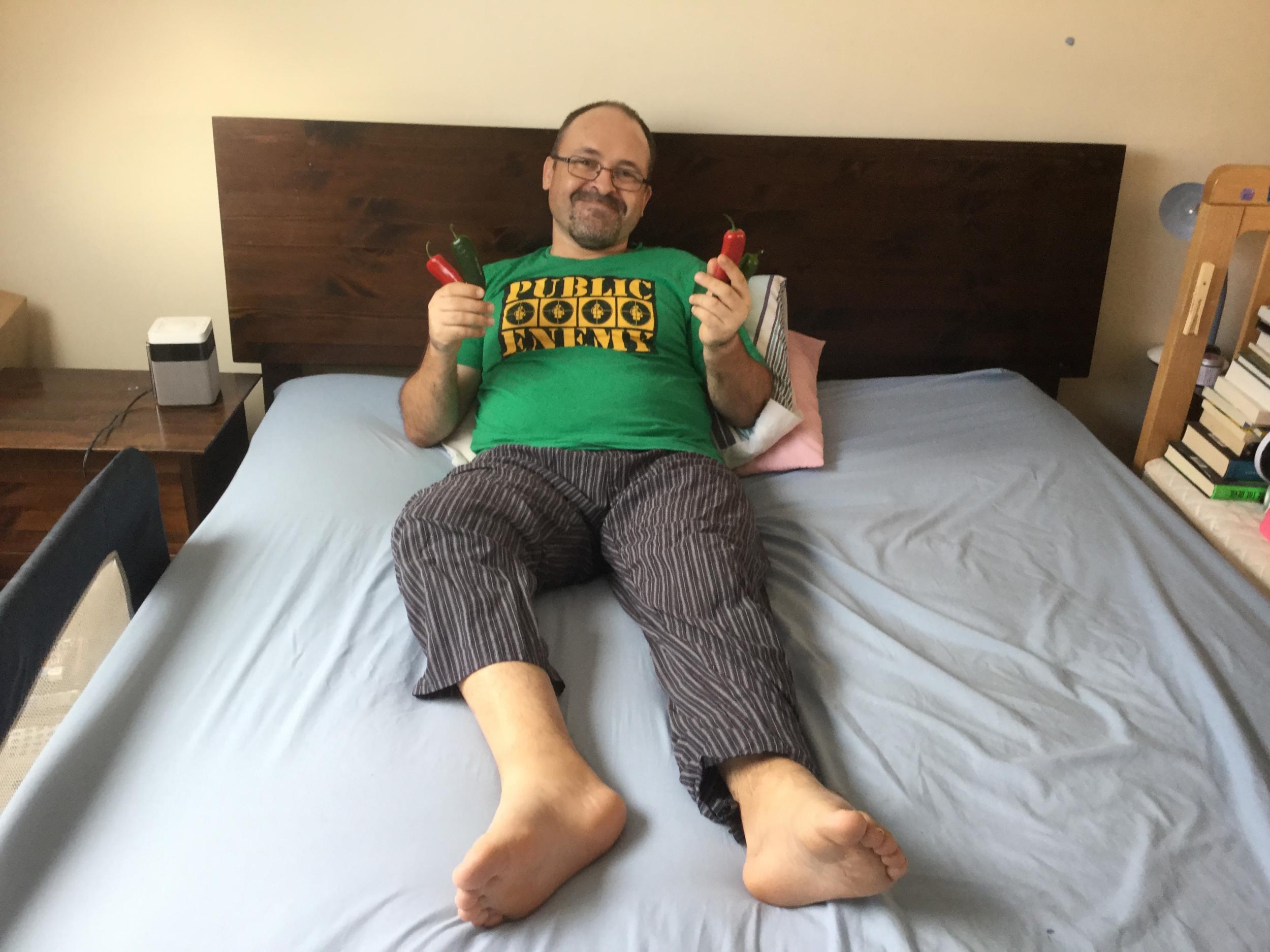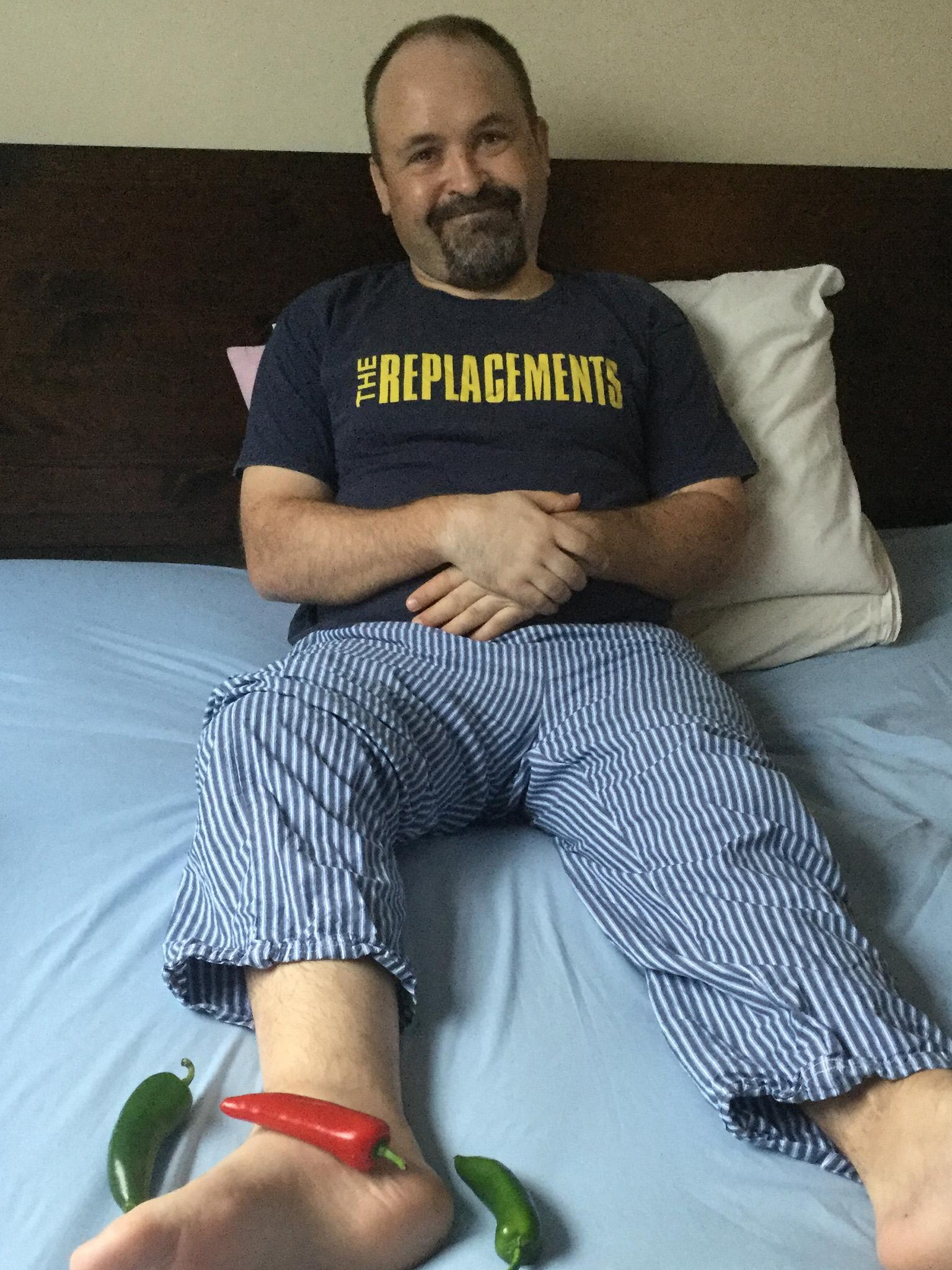Chilli remedy: Never has pain relief been so painful
An accident with a cement truck left our correspondent looking for an alternative to drugs to make his life a little easier. But he found himself on a journey featuring even more pain

Chilli peppers are some of my favourite things. It doesn’t matter if the food they’re in is Mexican, Indian, Chinese, Thai, or any type of fusion thereof, I’ll happily partake of them.
I’ve been known to eat them raw on occasion, and I’ll add chilli sauce to give a bit of life to just about anything. However, until very recently, I’d have drawn the line at putting them anywhere other than in my stomach.
As for using one of the active ingredients in the creation of that delightful burn as a method of relieving the agonising neuropathic (or nerve) pain from which I suffer?
Well you probably won’t be all that surprised to learn that my first reaction when it was suggested to me was, “Come again? Am I hearing this right?”
Actually, if I’m being honest, I think I smiled politely and nodded my head, as you do when clever doctors are speaking. But that’s what I was thinking.
The clever doctor in question was my pain consultant at the Royal National Orthopaedic Hospital in London, Dan Mihaylov.
He proposed to use a treatment involving a patch that facilitates the infusion of capsaicin – the active agent in chillis – through the skin and into the nerves beneath it.
Dr Mihaylov warned me that to do its work it would sting.
However, after receiving a thorough explanation of the treatment, and how it worked, I began to warm to the idea. It held out the prospect of reducing my pain, not to mention my need for a battery of painkilling drugs that come with side effects ranging from the irritating to the downright unpleasant.
Of course, I wasn’t aware at that time that about 20 minutes after the patches had been applied I would crying, “Get me some morphine!”

Imagine if you will, the most powerful hot dish you’ve ever sampled. I’m talking here about the ones that can leave you in tears, desperate for something to stop the burning. A particularly fierce curry, or even some of those chicken wings lathered in hot sauce made from Scotch bonnet peppers that some places challenge people to eat plates full of without expiring on the premises. Now multiply it by a factor of 10. You still won’t have got there.
Those patches burn. When doctors stay it will sting a bit they sometimes have a tendency to underestimate by quite how much. But part of it was down to me too.
I’m a past master in the experience of pain. I spent more time than I care to remember trapped under the wheels of a cement truck, then three months in hospital dealing with the aftermath. That was pretty uncomfortable. The neuro pain I continue to suffer from is just one of the ongoing challenges that that experience left me with.
All of that gave me the confidence that I could put up with just about anything. What’s a chill pepper patch when set against a cement truck on your ribs?
Dr Mihaylov initially suggested trying just one. He urged me not to put myself through too much. We could always book a follow-up.
No need, said I. Hit me with the lot. Whatever it takes to cover the area of discomfort, my foot and my lower leg. Because, of course, I’m just that hard. Or, in reality, just that stupid.
Unfortunately, the doctor took me at my word. Oops. At first I was left feeling pleased with myself. When the doctor asked me if it was stinging, I answered in the affirmative. However, it wasn’t too bad. Such a trouper!
Minutes later I was in a very different place. On the scale of one to 10 that they ask you to use to rate your pain it was at a 10 (of course being under the cement truck would be a 63).
In other words, it was getting too much to easily bear. Thing is even while I was contemplating whether I should have gone for the intravenous morphine instead of rejecting it in favour of a pill, I was still of the view that it was worth it because I knew it wouldn’t last. If it could have an impact on the longer term persistent pain which plagues me, it would be worth it.
Pain is an evolutionary necessity. In 2012 the Science Museum produced a video of Steven Pete for its exhibition “Painless”. Pete suffers from the rare genetic disorder congenital analgesia and explains how, when he was younger, he chewed off part of his tongue. On another occasion he broke his foot, taped it to his boot, and carried on with his day. He talked about banging his head against the wall as a child because he liked the feeling of the vibration it made.
So, yes, being able to feel pain is quite important. In fact, it is vital, to our survival as a species. However, I and 20 million others are living proof that you can have too much of a good thing.
Chronic pain can quite literally drive you mad. The continuous firing of those receptors, it can take over your existence.
The condition has drawn some attention recently as a result of the struggles of Anthony McPartlin, one half of the light entertainment juggernaut that is Ant and Dec. An addiction to drugs taken to control his chronic pain has seen him entering rehab.
For the most part those of us suffering along with him do so in silence. It is not a condition that gets much attention. It is not often discussed. As such, Mr McPartlin might have done us all a favour.

According to the reports, his pain is related to problems with his knee. Mine comes from misfiring nerves in my lower leg and I came to suffer from it as one of the consequences of having broken my pelvis, along with at least one of almost every other bone in my body courtesy of that accursed truck.
As a result of that injury, the peripheral nerves in my legs got scragged, particularly those in my right leg, which now has no useful movement below the knee. My right calf is now about half the size of the left (itself not in great shape) having wasted away.
And it constantly hurts. It really, really hurts.
Imagine having a million tiny acid-tipped needles constantly jabbing into your skin; a constant hot, prickling agony. That’s more or less what it feels like. It’s at work right now, as I write this.
It’s hard to wear socks, or shoes, which is particularly problematic in the winter. Even a duvet cover can set it off (ditto) and I don’t sleep much because of it.
As for putting weight on it? You may have heard of The Little Mermaid, by which I mean not Disney’s sepia-tinted version featuring the cute and smiling Ariel, but Hans Christian Andersen’s dark original.
The title character wanted legs to be able to walk on land, so she could be with her true love. These she obtained from the Sea Witch, but only at the cost of constantly feeling as if she was walking on sharp knives.
I know how that feels. It ain’t fun. If I’d been diving that day I’d have told her to stay under water, however much she loved her human prince.
There have been times when I have literally contemplated taking a bread knife to it, to the extent of sitting on a stool in my kitchen, eyeing it.
I actually asked my GP whether it would help to have it amputated. She explained that it would simply open the door to phantom pain, which is really a misnomer. To those that suffer from it, it’s all too real.
Still, I try my best to avoid taking maximum dose of the drugs I’m allowed, which include tramadol, the reported cause of Ant’s problems, because if I didn’t do that I’d struggle to work.
The stuff leaves me, if you’ll forgive me the use of slang, baked. It’s not a particularly unpleasant feeling. It’s rather like being smiley version of one of the title characters from Fear the Walking Dead. I can’t do a lot when I’m feeling like that.
Which is why I figured the capsaicin patches were worth trying, however much they hurt.
I’d already had some other options suggested to me. Some people in my position have lidocaine, a local anaesthetic, injected into them every few months. Unfortunately, I don’t have good veins. The insertion of needles and cannulas into them (which this treatment would require) can be extremely unpleasant, even more unpleasant than chilli pepper infusions.
With about a 20 per cent chance of success, and double-blind trials questioning its effectiveness for even those who feel it works, I wasn’t keen.
By the time I’d heard about option two, however, it was looking positively appealing. Option two would involve the insertion of an electrode into my spinal column with the aim of muffling the vagrant nerve signals that cause my discomfort.
The success rate is high, I was told, and there is a way to gauge its effectiveness before going ahead with the invasive surgery required to have the thing put in. I was also told that hardly anyone ever gets paralysed as a result of the operation, and the Royal National Orthopaedic has never had a case of it happening.
I just didn’t much fancy risking being the first, however slim the chance. I have enough paralysis, already, thanks very much.
One of the bewildering array of specialists that assessed me during the course of a legal case against the driver of the cement truck – well their insurers at any rate – was sceptical about its chances of helping me.

Both options made the capsaicin patches sound appealing by comparison.
The substance works by blocking one of the receptors involved in the transmission of neuropathic pain, and also by reducing the number and density of tiny nerve fibres under the epidermis, or skin, by burning them off.
“You cant use the patches all over the place. It has to be in a localised area,” explains the doc. “So I think it might help you. The other thing we have found useful in patients who have the treatment is that it can reduce sensitivity of the skin.”
That’s another problem that I have. While patches of the lower part of my leg are basically numb, others are hypersensitive, quite dangerous for someone like me. My balance is poor at the best of times. I only need to tread on a small piece of my children’s Lego at home to result in a crashing fall.
“It avoids the use of invasive surgery and can cut the use of drugs. We know it doesn’t get into the bloodstream and so it avoids a lot of side-effects. I like it as a treatment,” Dr Miyhalov says. He originally trained as an anaesthetist but was attracted to the challenge of the related field of pain, which wasn’t getting a lot of attention despite the high number of sufferers.
Fast forward to the hospital, and I was a little nonplussed. I was decked out in a gown, given a bed, and parked in it. It all seemed to me to be a bit of a to do given I was only going to have a chilli pepper patch applied.
Of course, this was before the patch was applied. Even having my leg covered in numbing anaesthetic cream and wrapped in clingfilm wasn't enough to stave off what was to follow. The burning continued long after I had returned to the ward.
“That’s a good sign,” the doctor assured me. “It shows that it’s working.”
Puts a whole new slant on the phrase “if it ain’t hurting it ain’t working”.
By the time I got home I’d abandoned any thoughts of restraint when it came to painkillers. I was on the full dose. The Moore household turned into the zombie household from my point of view, and the weekend was a write-off.
So did it work? Well, not really. For me, that’s been the sting in the tail of the chilli. The pain persists.
I was warned that the success rate was only about 50 per cent, and that even then I was likely to have to go in for follow-ups. Dr Mihaylov said only two of his patients hadn’t needed them.
Would I try it again? Well, yes. I’m just awaiting the follow-up conversation with the pain clinic to discuss whether that would be a sensible option.
At least if there is a next time I will know what’s coming, and I’ll be able to take steps to mitigate it, perhaps by taking the max dose of painkillers in advance.
What is also encouraging is that treatments like this are coming on stream (capsaicin has actually been around for a few years now).
Research into pain is ongoing. Steven Pete is playing a role. As the Science Museum video makes clear, his condition is caused by a mutation in a gene controlling just one protein. Its absence stops it from being transmitted. If they could use that knowledge to develop new treatments, then who knows.
In the meantime, I’ve been doing what I’ve been doing for the past six years: my best to put the discomfort in the background by keeping myself as busy as possible and writing pieces like this. It’s an imperfect remedy. It isn’t always effective, and it requires the drugs alongside it. But for now, it’s the best I can do.
Join our commenting forum
Join thought-provoking conversations, follow other Independent readers and see their replies
Comments